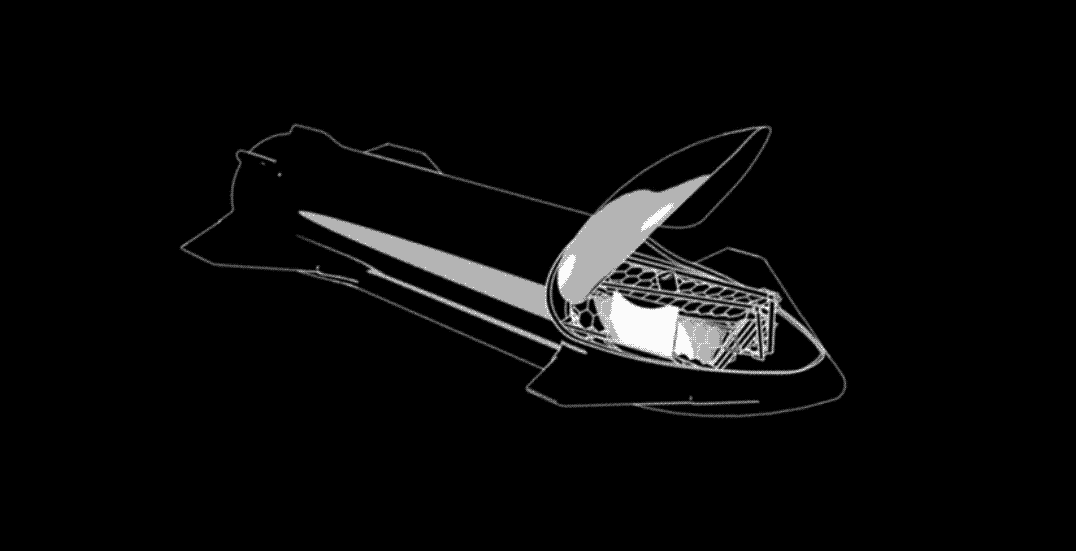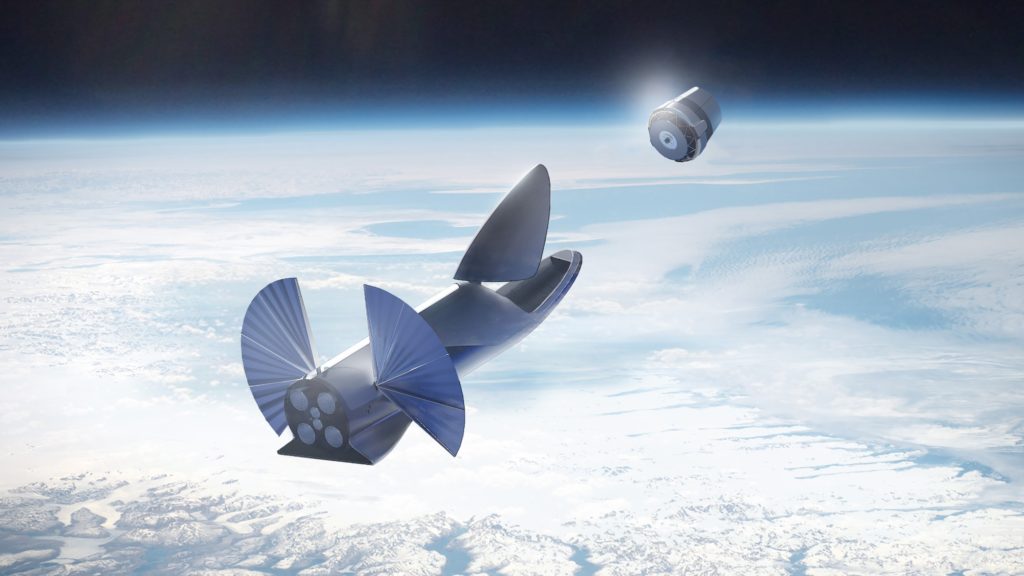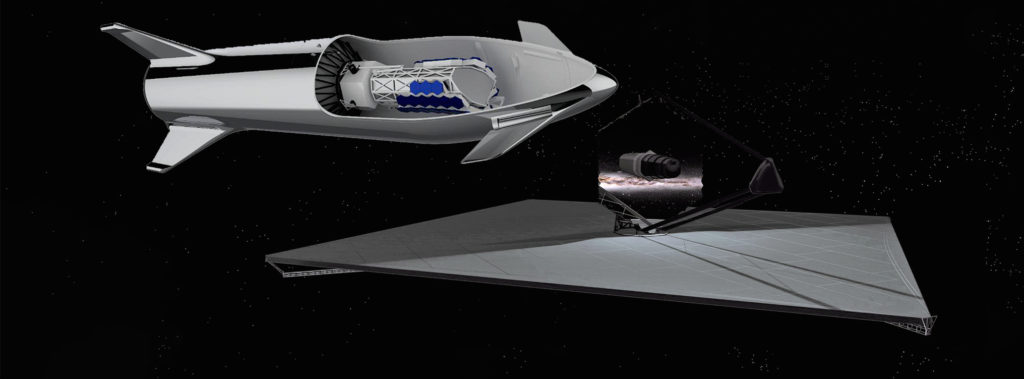

News
SpaceX CEO Elon Musk talks Starship space telescopes, artificial gravity
In his latest batch of tweets, SpaceX CEO Elon Musk says that the company is already thinking about the many potential ways its next-generation Starship launch vehicle could be used in space.
Already, ideas publicly touted by the SpaceX CEO range from using Cargo Starships to clean up space debris with its mouth-like payload bay to a stripped-down, expendable variant of the rocket to rapidly send massive spacecraft throughout the solar system. Now, Musk says that SpaceX has also considered tethering Starships together in space to create a form of artificial gravity for passengers on multi-month journeys between planets, as well as the possibility of turning entire Starships into all-in-one orbital observatories a magnitude more powerful than Hubble.


Apparently invoked during discussions with astrophysicist and Nobel laureate Saul Perlmutter, at least parts of the physics community are already considering the possibilities offered by using Starship as a sort of foundation or spacecraft bus that could carry and operate vast scientific payloads. While Starship has already been officially floated several times as a serious contender for launch services for major future missions, this concept would instead see Starship function as the spacecraft itself.
As of 2021, Starship has yet to reach space or orbit once, but SpaceX isn’t far from that milestone. Eventually, perhaps just a few years from now, Starship will have successfully launched to and operated in orbit dozens or even hundreds of times and become a mature and reliable spacecraft.
At that point, it wouldn’t be out of the question to entrust Starships themselves to serve as long-lasting scientific spacecraft, exploiting a ‘bus’ that could offer abundant power, propulsion, thermal management, navigation, and communications capabilities to any ‘hosted’ payloads. That includes extensively modifying Starships on the ground to create vast space observatories, among numerous other possibilities.
Given Starship’s low production cost, 9-meter (~30 ft) diameter, and nominal ability to deliver at least 100 metric tons (~220,000 lb) of payload to low Earth orbit (LEO), it’s not inconceivable that ships could be outfitted with massive telescopes and scientific instruments. Perhaps more importantly, drastically reduced payload constraints (more than an order of magnitude relative to the Hubble or James Webb telescopes) could allow major innovation in spacecraft/instrument design, radically lowering costs while still improving reliability, redundancy, and performance.
Meanwhile, Musk says that SpaceX has also considered tethering crewed Starships together and spinning them around the center of that tether to create artificial gravity for crewmembers on months-long journeys between Earth, Mars, and other planets. Among fan communities, the tethered gravity concept has been circulating ever since SpaceX first announced Starship in 2016. Loosely researched by NASA and other institutions for decades, no real experimental efforts – save for a single halting test during a 1960s Gemini mission – have ever been pursued.
For Starship, orbital refueling could easily allow SpaceX to cut crewed Earth-Mars transit time to 100 days or less – subjecting astronauts to significantly less time in microgravity than those that crew the International Space Station (ISS). The value proposition of artificial gravity on 3-month cruises is likely substantially less clear-cut given the far-reaching complexity and modifications required to make such a system functional and make Starships compatible.
Regardless, Musk rather cryptically says that SpaceX has considered the concept, though he didn’t elaborate on whether the company ultimately decided to drop the subject or pursue it further.

Elon Musk
Elon Musk’s X will start using a Tesla-like software update strategy
The initiative seems designed to accelerate updates to the social media platform, while maintaining maximum transparency.

Elon Musk’s social media platform X will adopt a Tesla-esque approach to software updates for its algorithm.
The initiative seems designed to accelerate updates to the social media platform, while maintaining maximum transparency.
X’s updates to its updates
As per Musk in a post on X, the social media company will be making a new algorithm to determine what organic and advertising posts are recommended to users. These updates would then be repeated every four weeks.
“We will make the new 𝕏 algorithm, including all code used to determine what organic and advertising posts are recommended to users, open source in 7 days. This will be repeated every 4 weeks, with comprehensive developer notes, to help you understand what changed,” Musk wrote in his post.
The initiative somewhat mirrors Tesla’s over-the-air update model, where vehicle software is regularly refined and pushed to users with detailed release notes. This should allow users to better understand the details of X’s every update and foster a healthy feedback loop for the social media platform.
xAI and X
X, formerly Twitter, has been acquired by Elon Musk’s artificial intelligence startup, xAI last year. Since then, xAI has seen a rapid rise in valuation. Following the company’s the company’s upsized $20 billion Series E funding round, estimates now suggest that xAI is worth tens about $230 to $235 billion. That’s several times larger than Tesla when Elon Musk received his controversial 2018 CEO Performance Award.
As per xAI, the Series E funding round attracted a diverse group of investors, including Valor Equity Partners, Stepstone Group, Fidelity Management & Research Company, Qatar Investment Authority, MGX, and Baron Capital Group, among others. Strategic partners NVIDIA and Cisco Investments also continued support for building the world’s largest GPU clusters.
News
Tesla FSD Supervised wins MotorTrend’s Best Driver Assistance Award
The decision marks a notable reversal for the publication from prior years, with judges citing major real-world improvements that pushed Tesla’s latest FSD software ahead of every competing ADAS system.

Tesla’s Full Self-Driving (Supervised) system has been named the best driver-assistance technology on the market, earning top honors at the 2026 MotorTrend Best Tech Awards.
The decision marks a notable reversal for the publication from prior years, with judges citing major real-world improvements that pushed Tesla’s latest FSD software ahead of every competing ADAS system. And it wasn’t even close.
MotorTrend reverses course
MotorTrend awarded Tesla FSD (Supervised) its 2026 Best Tech Driver Assistance title after extensive testing of the latest v14 software. The publication acknowledged that it had previously criticized earlier versions of FSD for erratic behavior and near-miss incidents, ultimately favoring rivals such as GM’s Super Cruise in earlier evaluations.
According to MotorTrend, the newest iteration of FSD resolved many of those shortcomings. Testers said v14 showed far smoother behavior in complex urban scenarios, including unprotected left turns, traffic circles, emergency vehicles, and dense city streets. While the system still requires constant driver supervision, judges concluded that no other advanced driver-assistance system currently matches its breadth of capability.
Unlike rival systems that rely on combinations of cameras, radar, lidar, and mapped highways, Tesla’s FSD operates using a camera-only approach and is capable of driving on city streets, rural roads, and freeways. MotorTrend stated that pure utility, the ability to handle nearly all road types, ultimately separated FSD from competitors like Ford BlueCruise, GM Super Cruise, and BMW’s Highway Assistant.
High cost and high capability
MotorTrend also addressed FSD’s pricing, which remains significantly higher than rival systems. Tesla currently charges $8,000 for a one-time purchase or $99 per month for a subscription, compared with far lower upfront and subscription costs from other automakers. The publication noted that the premium is justified given FSD’s unmatched scope and continuous software evolution.
Safety remained a central focus of the evaluation. While testers reported collision-free operation over thousands of miles, they noted ongoing concerns around FSD’s configurable driving modes, including options that allow aggressive driving and speeds beyond posted limits. MotorTrend emphasized that, like all Level 2 systems, FSD still depends on a fully attentive human driver at all times.
Despite those caveats, the publication concluded that Tesla’s rapid software progress fundamentally reshaped the competitive landscape. For drivers seeking the most capable hands-on driver-assistance system available today, MotorTrend concluded Tesla FSD (Supervised) now stands alone at the top.
News
Elon Musk’s Grokipedia surges to 5.6M articles, almost 79% of English Wikipedia
The explosive growth marks a major milestone for the AI-powered online encyclopedia, which was launched by Elon Musk’s xAI just months ago.

Elon Musk’s Grokipedia has grown to an impressive 5,615,201 articles as of today, closing in on 79% of the English Wikipedia’s current total of 7,119,376 articles.
The explosive growth marks a major milestone for the AI-powered online encyclopedia, which was launched by Elon Musk’s xAI just months ago. Needless to say, it would only be a matter of time before Grokipedia exceeds English Wikipedia in sheer volume.
Grokipedia’s rapid growth
xAI’s vision for Grokipedia emphasizes neutrality, while Grok’s reasoning capabilities allow for fast drafting and fact-checking. When Elon Musk announced the initiative in late September 2025, he noted that Grokipedia would be an improvement to Wikipedia because it would be designed to avoid bias.
At the time, Musk noted that Grokipedia “is a necessary step towards the xAI goal of understanding the Universe.”
Grokipedia was launched in late October, and while xAI was careful to list it only as Version 0.1 at the time, the online encyclopedia immediately earned praise. Wikipedia co-founder Larry Sanger highlighted the project’s innovative approach, noting how it leverages AI to fill knowledge gaps and enable rapid updates. Netizens also observed how Grokipedia tends to present articles in a more objective manner compared to Wikipedia, which is edited by humans.
Elon Musk’s ambitious plans
With 5,615,201 total articles, Grokipedia has now grown to almost 79% of English Wikipedia’s article base. This is incredibly quick, though Grokipedia remains text-only for now. xAI, for its part, has now updated the online encyclopedia’s iteration to v0.2.
Elon Musk has shared bold ideas for Grokipedia, including sending a record of the entire knowledge base to space as part of xAI’s mission to preserve and expand human understanding. At some point, Musk stated that Grokipedia will be renamed to Encyclopedia Galactica, and it will be sent to the cosmos.
“When Grokipedia is good enough (long way to go), we will change the name to Encyclopedia Galactica. It will be an open source distillation of all knowledge, including audio, images and video. Join xAI to help build the sci-fi version of the Library of Alexandria!” Musk wrote, adding in a later post that “Copies will be etched in stone and sent to the Moon, Mars and beyond. This time, it will not be lost.”








